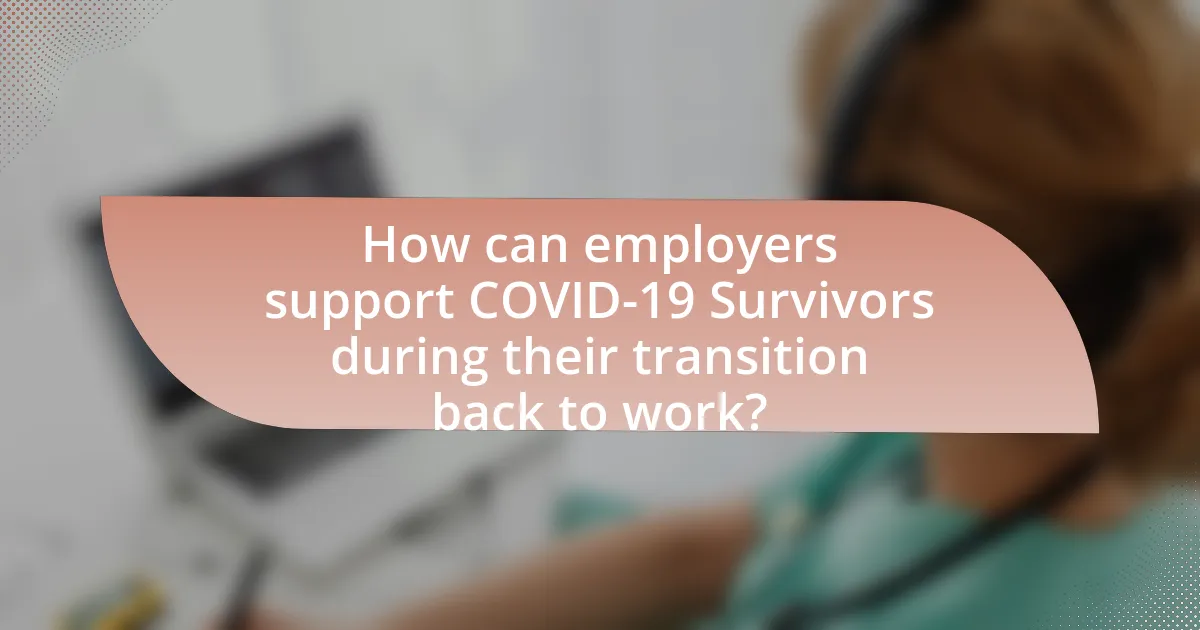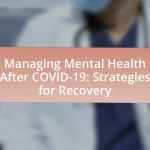Return-to-Work Plans for COVID-19 Survivors are structured strategies aimed at facilitating the safe reintegration of individuals who have recovered from COVID-19 into the workplace. These plans address the unique challenges faced by survivors, including lingering physical and mental health issues, by incorporating flexible work arrangements, health assessments, and mental health support. Key components of effective plans include clear communication of safety protocols, ongoing health evaluations, and tailored accommodations to enhance employee well-being and productivity. The article emphasizes the importance of comprehensive planning to mitigate health risks and improve workplace morale for COVID-19 survivors.

What are Return-to-Work Plans for COVID-19 Survivors?
Return-to-Work Plans for COVID-19 Survivors are structured strategies designed to facilitate the safe reintegration of individuals who have recovered from COVID-19 back into the workplace. These plans typically include assessments of the survivor’s health status, accommodations for any lingering symptoms, and guidelines for maintaining safety protocols to prevent further transmission of the virus. Evidence from the Centers for Disease Control and Prevention (CDC) indicates that many COVID-19 survivors may experience long-term effects, necessitating tailored approaches to ensure their well-being and productivity upon returning to work.
How do Return-to-Work Plans address the needs of COVID-19 Survivors?
Return-to-Work Plans address the needs of COVID-19 survivors by incorporating flexible work arrangements, health assessments, and mental health support. These plans often include options for remote work or modified duties to accommodate lingering symptoms such as fatigue or cognitive difficulties, which are common among survivors. Additionally, regular health assessments help monitor the physical and mental well-being of employees returning to work, ensuring that any ongoing health issues are addressed promptly. Mental health support services, such as counseling and stress management programs, are also integrated into these plans to assist survivors in coping with the psychological impacts of their illness. This comprehensive approach is essential, as studies indicate that a significant percentage of COVID-19 survivors experience long-term effects, necessitating tailored support in the workplace.
What specific challenges do COVID-19 Survivors face when returning to work?
COVID-19 survivors face several specific challenges when returning to work, including physical health issues, mental health concerns, and workplace accommodations. Many survivors experience lingering symptoms, known as “long COVID,” which can include fatigue, respiratory problems, and cognitive difficulties, impacting their ability to perform job duties effectively. Additionally, mental health challenges such as anxiety and depression are prevalent among survivors, complicating their reintegration into the workplace. Employers may need to provide accommodations, such as flexible work hours or modified responsibilities, to support these individuals. Research indicates that approximately 10-30% of COVID-19 patients experience long-term effects, highlighting the importance of addressing these challenges in return-to-work plans.
How can employers tailor Return-to-Work Plans for these individuals?
Employers can tailor Return-to-Work Plans for COVID-19 survivors by implementing flexible work arrangements, such as remote work options or modified schedules, to accommodate their health needs. This approach recognizes that many individuals may experience lingering symptoms, known as “long COVID,” which can affect their ability to perform traditional work hours. Research indicates that approximately 10-30% of COVID-19 patients report long-term symptoms, necessitating adjustments in the workplace to support their recovery. Additionally, employers should engage in open communication with affected employees to understand their specific challenges and preferences, ensuring that the Return-to-Work Plans are personalized and effective.
Why is it important to have a structured Return-to-Work Plan?
A structured Return-to-Work Plan is important because it facilitates a smooth transition for employees recovering from COVID-19 back into the workplace. This plan outlines clear steps and guidelines, ensuring that employees feel supported and safe as they reintegrate. Research indicates that structured plans can reduce anxiety and uncertainty, which are common among returning employees, thereby enhancing overall workplace morale and productivity. For instance, a study published in the Journal of Occupational Health Psychology found that structured reintegration processes significantly improved employee confidence and job satisfaction post-illness.
What are the potential consequences of inadequate planning for COVID-19 Survivors?
Inadequate planning for COVID-19 survivors can lead to significant health and economic consequences. Health issues may include the exacerbation of long COVID symptoms, which affect approximately 10-30% of individuals post-infection, resulting in fatigue, cognitive impairment, and respiratory problems. Economically, insufficient planning can lead to increased absenteeism and reduced productivity, as survivors may struggle to return to work effectively. Furthermore, a lack of support systems can increase mental health challenges, with studies indicating that COVID-19 survivors are at a higher risk for anxiety and depression. These consequences highlight the critical need for comprehensive return-to-work strategies that address both health and economic factors for COVID-19 survivors.
How can effective planning improve workplace safety and employee morale?
Effective planning enhances workplace safety and boosts employee morale by establishing clear protocols and expectations. When organizations implement comprehensive safety measures, such as risk assessments and emergency response plans, employees feel more secure in their environment, which directly correlates with increased morale. A study by the National Safety Council found that workplaces with well-defined safety plans experience 50% fewer accidents, leading to a more confident workforce. Additionally, effective planning fosters open communication and employee involvement in safety initiatives, which further elevates morale as employees feel valued and empowered.

What key components should be included in a Return-to-Work Plan?
A Return-to-Work Plan should include the following key components: assessment of employee health status, clear communication of workplace safety protocols, flexible work arrangements, and ongoing support for mental health. The assessment of employee health status ensures that individuals are fit to return, while clear communication of safety protocols helps mitigate risks associated with COVID-19. Flexible work arrangements, such as remote work options or staggered shifts, accommodate varying recovery timelines and personal circumstances. Ongoing support for mental health addresses the psychological impact of the pandemic, fostering a supportive work environment. These components are essential for a successful transition back to the workplace, as they prioritize employee well-being and safety.
How can health assessments be integrated into Return-to-Work Plans?
Health assessments can be integrated into Return-to-Work Plans by conducting comprehensive evaluations of an employee’s physical and mental health status prior to their return. These assessments help identify any ongoing health issues related to COVID-19, such as fatigue or respiratory problems, which may affect the employee’s ability to perform their job effectively. Research indicates that structured health assessments can improve workplace safety and employee well-being, as they allow for tailored accommodations based on individual health needs. For instance, a study published in the Journal of Occupational Health Psychology found that personalized return-to-work strategies significantly reduced the risk of relapse and enhanced productivity among employees recovering from health issues.
What types of health assessments are most relevant for COVID-19 Survivors?
Health assessments most relevant for COVID-19 survivors include pulmonary function tests, cardiovascular evaluations, and mental health screenings. Pulmonary function tests assess lung capacity and function, which is crucial since many survivors experience respiratory issues post-infection. Cardiovascular evaluations are important due to the increased risk of heart complications associated with COVID-19, as evidenced by studies indicating that survivors may have a higher incidence of myocarditis and other heart conditions. Mental health screenings are also essential, as research shows that COVID-19 survivors often face anxiety, depression, and PTSD, necessitating comprehensive mental health support.
How often should health assessments be conducted?
Health assessments should be conducted at least annually for most individuals, but for COVID-19 survivors, more frequent evaluations may be necessary, ideally every three to six months. This recommendation is based on the need to monitor potential long-term effects of COVID-19, such as respiratory issues or cognitive impairments, which can emerge after recovery. Research indicates that ongoing health assessments can help identify and address these complications early, improving overall health outcomes and facilitating a smoother return to work.
What role does flexible work arrangements play in these plans?
Flexible work arrangements are crucial in navigating return-to-work plans for COVID-19 survivors as they provide necessary adaptability to accommodate varying health conditions and personal circumstances. These arrangements allow individuals to manage their workload while considering potential lingering effects of COVID-19, such as fatigue or cognitive challenges. Research indicates that organizations implementing flexible work options report higher employee satisfaction and retention rates, which is particularly important for supporting the well-being of COVID-19 survivors during their transition back to work.
How can remote work options benefit COVID-19 Survivors?
Remote work options can significantly benefit COVID-19 survivors by providing a flexible and safe work environment that accommodates their health needs. Many survivors experience lingering symptoms, known as “long COVID,” which can include fatigue, respiratory issues, and cognitive difficulties. Remote work allows these individuals to manage their symptoms more effectively by reducing the stress of commuting and enabling them to work in a comfortable setting.
Studies indicate that remote work can lead to increased productivity and job satisfaction, particularly for those with health challenges. For instance, a report from the Stanford Graduate School of Business found that remote workers were 13% more productive than their in-office counterparts, highlighting the potential for improved performance among COVID-19 survivors who may struggle with traditional work environments. Additionally, remote work can facilitate better work-life balance, allowing survivors to prioritize their health while maintaining employment.
What are the best practices for implementing flexible schedules?
The best practices for implementing flexible schedules include establishing clear guidelines, ensuring open communication, and utilizing technology for scheduling. Clear guidelines help employees understand expectations and parameters of flexibility, which can enhance productivity and accountability. Open communication fosters trust and allows for adjustments based on individual needs and team dynamics. Utilizing technology, such as scheduling software, streamlines the process, making it easier for employees to manage their time effectively. Research indicates that organizations with flexible scheduling report higher employee satisfaction and retention rates, demonstrating the effectiveness of these practices in supporting a diverse workforce, particularly in the context of navigating return-to-work plans for COVID-19 survivors.

How can employers support COVID-19 Survivors during their transition back to work?
Employers can support COVID-19 survivors during their transition back to work by implementing flexible work arrangements, providing mental health resources, and ensuring a safe workplace environment. Flexible work arrangements, such as remote work options or adjusted hours, accommodate the varying recovery needs of survivors. Mental health resources, including access to counseling services and support groups, help address the psychological impact of the illness. Additionally, ensuring a safe workplace through enhanced sanitation measures and adherence to health guidelines fosters a sense of security for returning employees. These strategies are supported by studies indicating that workplace flexibility and mental health support significantly improve employee well-being and productivity during transitions.
What resources are available for COVID-19 Survivors returning to work?
COVID-19 survivors returning to work can access various resources, including workplace accommodations, mental health support, and rehabilitation services. The U.S. Equal Employment Opportunity Commission (EEOC) provides guidelines on reasonable accommodations for employees with disabilities, which can include those experiencing long-term effects of COVID-19. Additionally, the Centers for Disease Control and Prevention (CDC) offers resources for employers to support the health and safety of returning employees. Mental health resources, such as counseling services and support groups, are also available through organizations like the National Alliance on Mental Illness (NAMI). These resources collectively aim to facilitate a smoother transition back to the workplace for COVID-19 survivors.
How can Employee Assistance Programs (EAPs) aid in this transition?
Employee Assistance Programs (EAPs) can significantly aid in the transition back to work for COVID-19 survivors by providing mental health support, counseling services, and resources tailored to address the unique challenges faced during recovery. EAPs offer confidential access to professional counselors who can help employees cope with anxiety, stress, and other emotional difficulties that may arise from their experiences with COVID-19. Research indicates that organizations utilizing EAPs report improved employee well-being and productivity, as these programs facilitate a smoother reintegration process by addressing both psychological and practical concerns related to returning to the workplace.
What training or workshops can help educate staff about COVID-19 Survivors’ needs?
Training programs focused on trauma-informed care and mental health support can effectively educate staff about COVID-19 survivors’ needs. These workshops should cover the psychological and physical impacts of COVID-19, emphasizing the importance of empathy and understanding in the workplace. Research indicates that trauma-informed approaches improve staff interactions with individuals who have experienced significant health challenges, fostering a supportive environment. Additionally, training on workplace accommodations and flexible policies can help staff better assist COVID-19 survivors in their transition back to work.
What are the best practices for communication during the return process?
Effective communication during the return process for COVID-19 survivors involves clear, empathetic, and consistent messaging. Organizations should provide regular updates about safety protocols, workplace changes, and support resources available to employees. This approach fosters trust and transparency, which are crucial for easing anxiety among returning employees. Research indicates that clear communication can significantly reduce stress and improve employee morale, as seen in a study published by the Journal of Occupational Health Psychology, which found that effective communication during organizational changes leads to higher employee satisfaction and engagement.
How can employers ensure open lines of communication with returning employees?
Employers can ensure open lines of communication with returning employees by implementing regular check-ins and feedback sessions. These structured interactions allow employees to express concerns, share experiences, and discuss any adjustments needed for their return. Research indicates that organizations with frequent communication practices report higher employee satisfaction and engagement levels, which is crucial for those transitioning back to work after health challenges like COVID-19. Additionally, utilizing multiple communication channels, such as emails, virtual meetings, and anonymous surveys, can further enhance transparency and accessibility, fostering a supportive environment for returning employees.
What feedback mechanisms should be in place to address concerns?
Effective feedback mechanisms to address concerns for COVID-19 survivors returning to work include regular check-ins, anonymous surveys, and dedicated support channels. Regular check-ins allow managers to gauge employee well-being and address issues promptly, fostering open communication. Anonymous surveys can collect honest feedback on workplace conditions and support services, ensuring that employees feel safe sharing their concerns without fear of repercussions. Dedicated support channels, such as HR hotlines or mental health resources, provide employees with direct access to assistance and guidance tailored to their needs. These mechanisms are essential for creating a supportive work environment that acknowledges and addresses the unique challenges faced by COVID-19 survivors.
What practical tips can help facilitate a smooth return to work for COVID-19 Survivors?
Practical tips to facilitate a smooth return to work for COVID-19 survivors include gradual reintegration into the workplace, open communication with employers about health needs, and ensuring a supportive work environment. Gradual reintegration allows survivors to adjust physically and mentally, reducing the risk of overwhelming fatigue or stress. Open communication is crucial; studies show that employees who discuss their health concerns with management report higher job satisfaction and lower anxiety levels. Additionally, creating a supportive work environment, such as flexible work hours or remote work options, can significantly enhance recovery and productivity, as evidenced by research from the American Psychological Association, which highlights the importance of workplace support in employee well-being.


